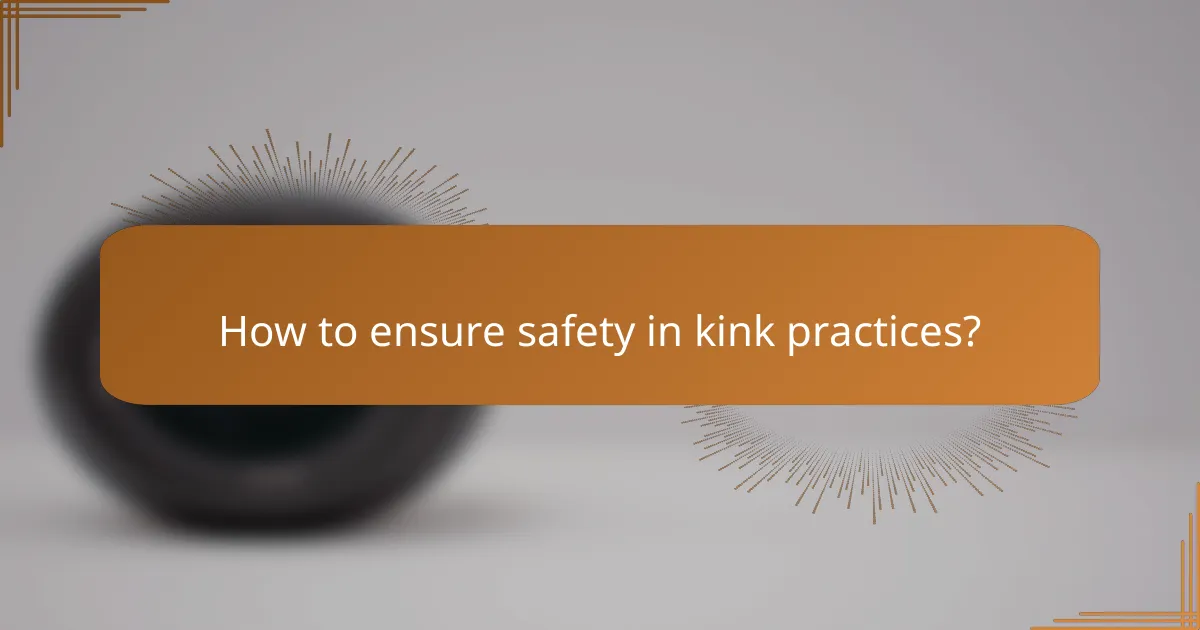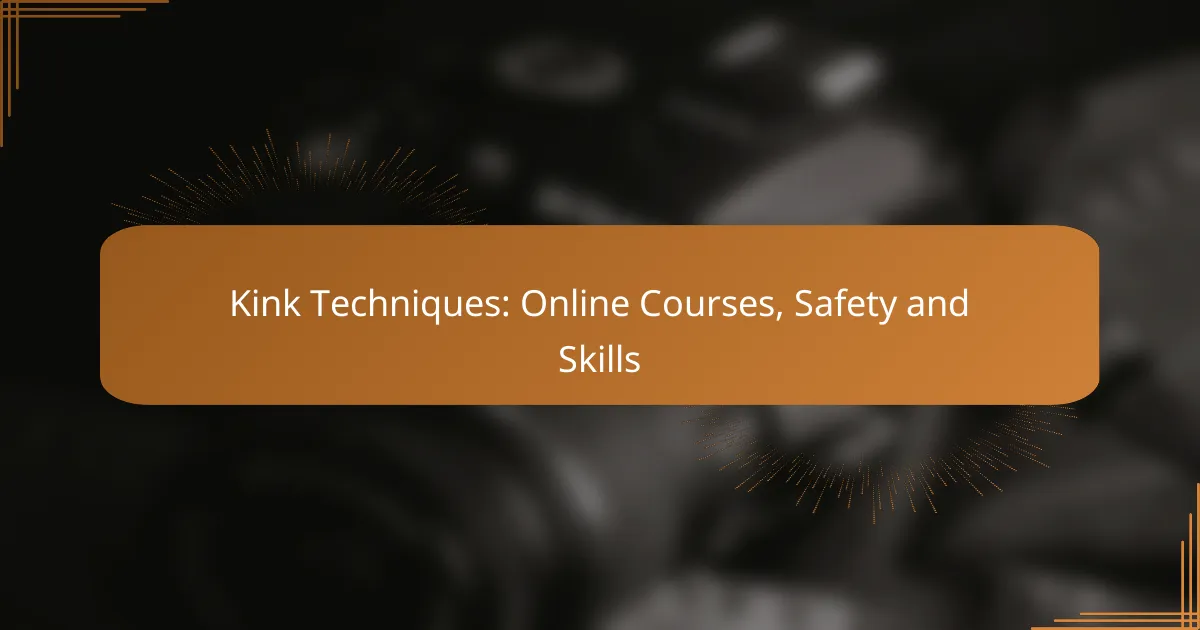Online courses for kink techniques offer valuable insights into the essential skills and safety knowledge needed for engaging in [censured] and related activities. These courses emphasize the importance of consent, communication, and proper techniques, enabling participants to explore their interests safely and responsibly.

What are the best online courses for kink techniques?
The best online courses for kink techniques provide practical skills and safety knowledge essential for exploring [censured] and related activities. These courses often cover a range of topics, from consent and communication to specific techniques and safety measures.
Sexual Health Alliance courses
Sexual Health Alliance offers a variety of online courses focused on kink techniques, emphasizing consent, communication, and safety. Their curriculum includes modules on [censured] fundamentals, risk-aware practices, and relationship dynamics.
These courses are designed for all levels, from beginners to experienced practitioners, and often include interactive elements such as quizzes and discussion forums. Certificates of completion may be available, enhancing your credentials in the kink community.
Kink Academy workshops
Kink Academy provides a wide range of workshops that focus on specific kink techniques, such as [censured], impact play, and sensation play. Each workshop typically includes video demonstrations, written guides, and tips for safe practice.
Members can access a library of content, with new workshops added regularly. The platform encourages a community atmosphere, allowing participants to share experiences and ask questions, which can enhance learning and skill development.
FetLife community classes
FetLife offers community-driven classes where members can share their knowledge and experiences related to kink techniques. These classes vary widely in topic and format, often reflecting the interests and expertise of community members.
While some classes may be informal, others can provide valuable insights and practical tips. Engaging with the FetLife community can help you find local events or online sessions that suit your interests and skill level.

How to ensure safety in kink practices?
Ensuring safety in kink practices involves clear communication, proper equipment, and a strong understanding of consent. By focusing on these key areas, participants can create a secure environment that allows for exploration while minimizing risks.
Establishing safe words
Safe words are essential in kink practices as they provide a clear and immediate way for participants to communicate their comfort levels. A common approach is to use a traffic light system: “red” for stop, “yellow” for slow down, and “green” for continue. This system allows for quick understanding during intense experiences.
It’s important to choose safe words that are easy to remember and unlikely to be confused with other terms used during play. Regularly discussing and reaffirming these words before engaging in activities can enhance trust and safety.
Using safe equipment
Using safe equipment is crucial for minimizing physical risks during kink activities. This includes ensuring that all tools, restraints, and toys are made from body-safe materials and are in good condition. Regularly inspecting equipment for wear and tear can prevent accidents.
When selecting gear, consider the specific needs of the activity. For example, using padded cuffs instead of rope can reduce the risk of injury. Always have safety scissors nearby to quickly release someone if necessary.
Understanding consent
Consent is the cornerstone of safe kink practices. It must be informed, enthusiastic, and ongoing, meaning that participants should feel free to withdraw consent at any time. Discussing boundaries and limits beforehand helps establish a mutual understanding of what is acceptable.
Regular check-ins during activities can reinforce consent and ensure that everyone remains comfortable. It’s beneficial to create an environment where participants feel empowered to express their needs and concerns without fear of judgment.

What skills are essential for kink enthusiasts?
Essential skills for kink enthusiasts include understanding consent, communication, and specific techniques related to various practices. Mastery of these skills ensures safety, enhances experiences, and fosters trust between partners.
[censured] techniques
[censured] techniques involve the safe and consensual restraint of a partner using ropes, cuffs, or other materials. Key considerations include understanding the types of knots, the importance of circulation, and the ability to communicate comfort levels during play.
Practicing basic knots like the square knot or the bowline can help beginners gain confidence. Always keep safety scissors nearby to quickly release a partner if necessary. Start with simple ties and gradually explore more complex patterns as skills improve.
Impact play skills
Impact play skills focus on delivering controlled strikes to the body using hands, paddles, or whips. It is crucial to establish boundaries and safe words before engaging in this type of play to ensure both partners feel secure.
Beginners should start with lighter implements and gradually increase intensity based on feedback. Understanding anatomy can help avoid sensitive areas and enhance the experience. Always check in with your partner during and after play to assess comfort and enjoyment.
Role-playing dynamics
Role-playing dynamics involve taking on specific personas or scenarios to enhance the kink experience. This can range from power exchange roles, such as dominant and submissive, to more elaborate character-based scenarios.
Clear communication about expectations and limits is vital before engaging in role play. Consider creating a safe word specific to the scenario to maintain comfort. Experimenting with different roles can deepen intimacy and understanding between partners.

What prerequisites should I consider before starting kink courses?
Before starting kink courses, it’s essential to assess your personal limits, understand the dynamics of kink communities, and ensure you have a clear idea of what you want to learn. Being aware of these factors will help you choose the right courses and engage safely and effectively.
Understanding personal limits
Identifying your personal limits is crucial before engaging in kink activities. This involves reflecting on what you are comfortable with, both physically and emotionally, and setting boundaries that you are not willing to cross. Consider discussing these limits with a trusted partner or mentor to gain clarity.
It’s also helpful to create a checklist of activities you are interested in exploring versus those you want to avoid. This can serve as a guide during your learning process and help you communicate effectively with others in the kink community.
Researching kink communities
Familiarizing yourself with kink communities can enhance your learning experience and provide valuable support. Start by exploring online forums, social media groups, and local meetups where you can connect with experienced practitioners and newcomers alike. Engaging with these communities will help you gain insights into different practices and safety protocols.
When researching, pay attention to the values and ethics of the communities you join. Look for groups that emphasize consent, safety, and respect, as these principles are fundamental to a positive kink experience. Consider attending workshops or events to meet people and learn in a supportive environment.

How to choose the right kink course for your needs?
Choosing the right kink course involves assessing your personal interests, safety considerations, and the quality of the instruction. Look for courses that align with your goals and offer comprehensive information on techniques and safety practices.
Assessing instructor credentials
Evaluate the qualifications and experience of the instructor leading the kink course. Look for certifications in relevant areas, such as [censured] practices or sexual health, and consider their teaching experience and community reputation.
Instructors with a strong background in kink and a history of positive feedback are more likely to provide valuable insights and ensure a safe learning environment. Don’t hesitate to ask about their experience during initial inquiries.
Evaluating course content
Review the syllabus and materials provided in the kink course to ensure they cover essential topics such as safety protocols, consent, and various techniques. A well-structured course should include both theoretical knowledge and practical exercises.
Consider whether the course offers a mix of beginner and advanced content, allowing you to progress at your own pace. Look for courses that provide resources or references for further learning, as this can enhance your understanding.
Considering peer reviews
Check for reviews and testimonials from previous participants to gauge the effectiveness and quality of the kink course. Positive feedback can indicate a course that successfully meets the needs of its students.
Look for reviews on independent platforms or forums dedicated to kink education, as these can provide unbiased opinions. Pay attention to comments regarding instructor engagement, course structure, and overall satisfaction to make an informed decision.

What are the emerging trends in kink education?
Emerging trends in kink education focus on accessibility and innovative methods of learning, particularly through online platforms. As interest in kink grows, more educators are utilizing technology to provide safe, informative, and engaging experiences for practitioners of all levels.
Virtual reality kink experiences
Virtual reality (VR) kink experiences are becoming increasingly popular as they offer immersive environments for exploration and education. These experiences can simulate real-life scenarios, allowing users to practice techniques and understand dynamics in a controlled setting.
When engaging with VR kink experiences, consider the quality of the technology and the content being offered. Look for platforms that prioritize safety and consent, providing clear guidelines and support for users. Examples of VR kink experiences may include role-playing scenarios or educational workshops that teach specific skills.
To make the most of VR kink experiences, ensure your equipment is up to date and comfortable. Familiarize yourself with the platform’s features and community guidelines. Avoid platforms that lack transparency regarding user safety and data privacy, as these are crucial for a positive experience.


